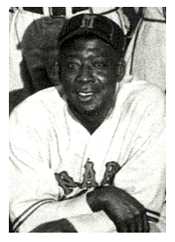

Wilbur Rogan
Nickname: Bullet, Bullet Joe
Career: 1917-1938; 1939-1946
Positions: p, of, 1b, 2b, 3b, ss, manager, umpire
Teams: Kansas City Colored Giants (1917), All Nations (1917), Kansas City Monarchs (1920-1938)
Bats: Right
Throws: Right
Height: 5' 7'' Weight: 180
Born: July 28, 1889, Oklahoma City, Oklahoma
Died: March 4, 1967, Kansas City, Missouri
National Baseball Hall of Fame Inductee (1998)
An outstanding pitcher with a tremendous fastball, a fine curve, and good control, "Bullet" Rogan was a star for the Kansas City Monarchs for almost twenty years. The right-hander was a smart pitcher who used a no-windup delivery, a sidearm motion, and always kept the ball down. In addition to his basic pitches, he included a forkball, palmball, and spitter in his repertory. A durable workhorse averaging thirty starting assignments per year for a decade and rarely being relieved, this versatile player's value to the team was inestimable. He also was a superb fielder and a dangerous hitter with good power.
He had strong wrists and used a heavy bat, and when not performing on the mound, he played in the outfield to keep his big bat in the lineup. A good curveball hitter with a smooth swing, he often batted in the cleanup position, and was credited with a league high 16 homers in 1922. He consistently hit over .300, compiling averages of .351, .416, .412, .366, .314, .330, .353, .341, and .311 for the years 1922-1930. On the mound he registered seasons of 13-6, 12-8, 16-5, 15-2, 12-4, 15-6, and 9-3 for the first seven of those years.
He showcased his stamina and versatility when he gained 2 victories with a single loss in the 1924 Negro World Series against the great Hilldale club, pitching 3 complete games and relieving in another while compiling a 2.57 ERA and batting .325 while playing in the outfield in the other 6 games. That winter, in his only trip to Cuba, the hard worker continued his winning pace with Almendares, recording a 9-4 work sheet, tying him for the league lead in victories.
The following year, without Rogan on the mound in the World Series due to an injury incurred while playing with his young son, the Monarchs lost to the same Hilldale club. However, in the playoffs for the league championship against the St. Louis Stars, he hit. 500. In 1926 he assumed the team's managerial reins, and with his leadership and performance at bat and on the mound, the Monarchs won the first-half championship before losing a heartbreaking 5-out-of-9 playoff to the second half champions, the Chicago American Giants. Rogan batted .583 and, in a valiant effort to stave off defeat, started both ends of a double-header on the last day of the playoff, but to no avail as he dropped both contests to Willie Foster, who also pitched both games.
The Monarchs captured another Negro National League pennant in 1929, but the next year Rogan was seriously ill and, at the end of the season, the club disbanded. In August 1931 the team was reorganized and, having regained his health, Rogan resumed his role as manager, and most of the ex-Kansas City players signed again with the Monarchs. A knowledgeable manager, he provide capable leadership and continued as manager of the Monarchs during his twilight years, until his retirement in 1938. During this time he was variously described as easygoing, jolly, quiet, and gentlemanly by some observers, but characterized by others as arrogant, uncooperative, and demanding of his players.
An Oklahoman by birth, he was reared in Kansas City, Kansas, and began his baseball career as a catcher with Fred Palace's Colts in 1908. The next season he played with the Kansas City Giants, and was credited with 54 consecutive wins at that level of competition before joining the Army in the fall of 1911. He remained in the Army through 1919, captaining the camp baseball teams while stationed in the Philippines, Hawaii, and Arizona. While playing baseball with the infantry baseball team at Fort Huachua, he was recommended by Casey Stengel to J.L. Wilkinson, owner of the All Nations baseball team. Rogan was signed and played as a shortstop left fielder-pitcher with the 1917 All Nations team. Wilkinson also owned the Kansas City Monarchs, and when he entered the Monarchs in the first Negro National League, he moved Rogan to the league club. The hard throwing right-hander also played in the California winter league with the Los Angeles White Sox in 1917 and again in 1920, as a pitcher hitting fifth in the batting order. He had slim legs and hips, but a solid upper torso with square shoulders and a trim, military bearing that made him appear bigger than his actual size.
In exhibitions against major leaguers, Rogan is credited with a .329 batting average, making his last appearance at age forty-eight, when he collected 3 hits against Bob Feller's All Stars. Jocko Conlan, who often played against black teams before beginning his career as an umpire, regarded Rogan as one of the greats of the Negro Leagues, describing his motion as "a nice, easy delivery" and declaring him to be faster than Satchel Paige. After closing out his managerial career, Rogan followed Conlan's progression from player to arbiter, and umpired in the Negro American League through the 1946 season. After retiring from his second baseball career he worked in the post office in Kansas City.
He was inducted posthumously into the National Baseball Hall of Fame in 2006.
Source: James A. Riley, The Biographical Encyclopedia of the Negro Baseball Leagues, New York: Carroll & Graf Publishers, Inc., 1994.

Wilbur "Bullet" Rogan